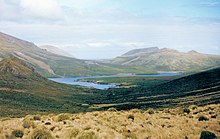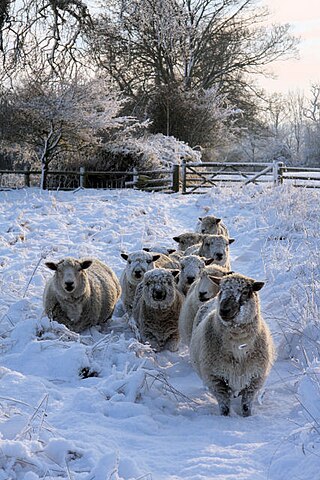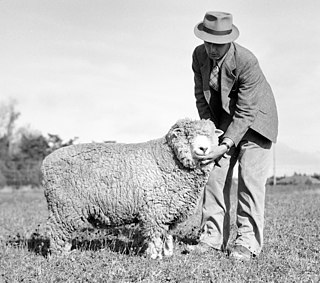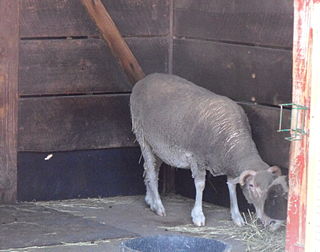
Campbell Island sheep are a feral breed of domestic sheep formerly found on New Zealand's subantarctic Campbell Island.

Campbell Island sheep are a feral breed of domestic sheep formerly found on New Zealand's subantarctic Campbell Island.
The sheep were originally introduced to Campbell Island in the late 1890s, following the inclusion of the island in New Zealand’s pastoral lease system in 1896. The lease was first taken up by James Gordon of Gisborne, who shipped 400 sheep, along with timber for buildings, to the island. After financial difficulties, in 1900 the lease was bought out by Captain Tucker of the Gisborne Militia who stocked the island with at least three shipments of about 1,000 sheep, mainly merino or merino cross. Two businessmen from Otago, J. Mathewson and D. Murray, became the next lessees in 1916, forming the Campbell Island Company (later a Syndicate) to manage the farm, employing shepherds and shearers to work for one-year periods on the island. [1] [2]
In 1927 the lease was auctioned and bought by John Warren, a farmer from Waitati, who brought another 5000 sheep to the island. However, wool and meat prices slumped in 1929 and, two years later, a destitute Warren and his farm workers returned to the mainland, abandoning the farm and the sheep. The lease to the island was declared forfeit in 1934 and expired in 1937. That year the island was set aside for the preservation of its flora and fauna, though its gazettal as a nature reserve did not take place until 1954. [1] [2]
With an initial abundance of palatable food, sheep numbers increased to a peak in about 1913 of 7-8000. Gradually, as the palatable plants became eaten out, the population went into a decline, with the flock down to 4000 in 1931 when it was abandoned. In 1958 a count of the sheep found about 1000 remaining. [1]
However, there was some subsequent recovery in numbers. In 1970 a fence was built across the island with all 1300 sheep on the northern side being shot, with a similar number on the southern side being left for the time being. By the late 1980s all the remaining sheep were culled, after a rescue expedition in 1975/76 removed ten live sheep for captive breeding in New Zealand. Descendants of the rescued sheep were maintained as a purebred flock until 2005. [1]

The Merino is a breed or group of breeds of domestic sheep, characterised by very fine soft wool. It was established in Spain near the end of the Middle Ages, and was for several centuries kept as a strict Spanish monopoly; exports of the breed were not allowed, and those who tried risked the death penalty. During the eighteenth century, flocks were sent to the courts of a number of European countries, including France, Hungary, the Netherlands, Prussia, Saxony, Estonia, Livonia and Sweden. The Merino subsequently spread to many parts of the world, including South Africa, Australia, and New Zealand. Numerous recognised breeds, strains and variants have developed from the original type; these include, among others, the American Merino and Delaine Merino in the Americas, the Australian Merino, Booroola Merino and Peppin Merino in Oceania, the Gentile di Puglia, Merinolandschaf and Rambouillet in Europe.

The North Ronaldsay or Orkney is a breed of sheep from North Ronaldsay, the northernmost island of Orkney, off the north coast of Scotland. It belongs to the Northern European short-tailed sheep group of breeds, and has evolved without much cross-breeding with modern breeds. It is a smaller sheep than most, with the rams (males) horned and ewes (females) mostly hornless. It was formerly kept primarily for wool, but now the two largest flocks are feral, one on North Ronaldsay and another on the Orkney island of Auskerry. The Rare Breeds Survival Trust lists the breed as a priority on its 2021–2022 watchlist, and they are in danger of extinction, with fewer than 600 registered breeding females in the United Kingdom.

Campbell Island / Motu Ihupuku is an uninhabited subantarctic island of New Zealand, and the main island of the Campbell Island group. It covers 112.68 square kilometres (43.51 sq mi) of the group's 113.31 km2 (43.75 sq mi), and is surrounded by numerous stacks, rocks and islets like Dent Island, Folly Island, Isle de Jeanette-Marie, and Jacquemart Island, the latter being the southernmost extremity of New Zealand. The island is mountainous, rising to over 500 metres (1,640 ft) in the south. A long fiord, Perseverance Harbour, nearly bisects it, opening out to sea on the east coast.

Mana Island is the smaller of two islands that lie off the southwest coast of the North Island of New Zealand. The name of the Island is an abbreviation of the Maori name Te Mana o Kupe, which means "The Mana of Kupe".

The Soay sheep is a breed of domestic sheep descended from a population of feral sheep on the 100-hectare (250-acre) island of Soay in the St Kilda Archipelago, about 65 kilometres (40 mi) from the Western Isles of Scotland. It is one of the Northern European short-tailed sheep breeds.

The Border Leicester is a British breed of sheep. It is a polled, long-wool sheep and is considered a dual-purpose breed as it is reared both for meat and for wool. The sheep are large but docile. They have been exported to other sheep-producing regions, including Australia and the United States.

The Ryeland is one of the oldest English sheep breeds going back seven centuries when the monks of Leominster in Herefordshire bred sheep and grazed them on the rye pastures, giving them their name. It was introduced into Australia in 1919 and are classified as an endangered breed by the Rare Breeds Trust of Australia and also are one of the nine heritage breeds that were the foundation of the sheep and wool industry in Australia. The Ryeland was one of the breeds used to introduce the poll gene to the Dorset breed in the development of the Poll Dorset. This breed is raised primarily for meat.

The Corriedale is a New Zealand breed of sheep. It was bred from about 1882 in the South Island by James Little, who cross-bred Merino and Lincoln Longwool sheep. The breed was officially recognised in 1911. It has been exported to Australia and to many countries in Africa, Asia, Europe and North and South America. In 2021 it was reported from twenty-five countries, and the total population was estimated at just over 5 million.

The Dorset Horn is an endangered British breed of domestic sheep. It is documented from the seventeenth century, and is highly prolific, sometimes producing two lambing seasons per year. Among British sheep, it is the only breed capable of breeding throughout the winter.

The Livestock Conservancy, formerly known as the American Livestock Breeds Conservancy (ALBC) and prior to that, the American Minor Breeds Conservancy, is a nonprofit organization focused on preserving and promoting rare breeds, also known as "heritage breeds" of livestock. Founded in 1977, through the efforts of livestock breed enthusiasts concerned about the disappearance of many of the US's heritage livestock breeds, the Conservancy was the pioneer livestock preservation organization in the United States, and remains a leading organization in that field. It has initiated programs that have saved multiple breeds from extinction, and works closely with similar organizations in other countries, including Rare Breeds Canada. With 3,000 members, a staff of nine and a 19-member board of directors, the organization has an operating budget of almost half a million dollars.

The Rare Breeds Conservation Society of New Zealand (RBCSNZ) was founded in 1988 to conserve, record and promote rare livestock breeds with the aim of maintaining genetic diversity within livestock species. The area of coverage is broad, and includes poultry as well as camelids, cattle, chinchillas, deer, donkeys, goats, horses, pigs, rabbits and sheep.

Hog Island sheep are a breed of sheep descended from animals first brought to Virginia's Hog Island in the 18th century. During the 1930s and 1940s, storm conditions forced the island's residents to evacuate, leaving some sheep behind. These sheep adapted to the environment free of human intervention, becoming feral.

Santa Cruz sheep are an extremely rare breed of domestic sheep that once existed as a feral population on the Santa Cruz Island of the Channel Islands of California. Small and hardy, the sheep were all killed or removed from the island to prevent destruction of natural habitats. Today, they number fewer than 200 animals. This breed is primarily raised for wool.
Campbell Island cattle were a feral breed of domestic cattle found on Campbell Island, New Zealand. From photographs taken in 1976 it appeared that the cattle were at least partly of shorthorn origin. This breed is now extinct.

Sheep or domestic sheep are domesticated, ruminant mammals typically kept as livestock. Although the term sheep can apply to other species in the genus Ovis, in everyday usage it almost always refers to domesticated sheep. Like all ruminants, sheep are members of the order Artiodactyla, the even-toed ungulates. Numbering a little over one billion, domestic sheep are also the most numerous species of sheep. An adult female is referred to as a ewe, an intact male as a ram, occasionally a tup, a castrated male as a wether, and a young sheep as a lamb.

The Boreray, also known as the Boreray Blackface or Hebridean Blackface, is a breed of sheep originating on the St Kilda archipelago off the west coast of Scotland and surviving as a feral animal on one of the islands, Boreray. The breed was once reared for meat and wool, but is now used mainly for conservation grazing. The Boreray is one of the Northern European short-tailed sheep group of breeds.

A station or run, in the context of New Zealand agriculture, is a large farm dedicated to the grazing of sheep and cattle. The use of the word for the farm or farm buildings date back to the mid-nineteenth century. The owner of a station is called a runholder.

The Arapawa Sheep is a breed of feral sheep found primarily on Arapaoa Island in the Marlborough Sounds, New Zealand, where they have probably been isolated since they were introduced in 1867. Although there are many theories of how the sheep arrived, it is generally accepted that they are descendants of Merino strains from Australia. The New Zealand Rare Breeds Conservation Society classifies this breed as "rare". This breed is raised primarily for wool.

The history of the domestic sheep goes back to between 11,000 and 9,000 BC, and the domestication of the wild mouflon in ancient Mesopotamia. Sheep are among the first animals to have been domesticated by humans. These sheep were primarily raised for meat, milk, and skins. Woolly sheep began to be developed around 6000 BC. They were then imported to Africa and Europe via trading.

Sheep farming is a significant industry in New Zealand. According to 2007 figures reported by the Food and Agriculture Organization (FAO) of the United Nations, there are 39 million sheep in the country. The country has the highest density of sheep per unit area in the world. For 130 years, sheep farming was the country's most important agricultural industry, but it was overtaken by dairy farming in 1987. Sheep numbers peaked in New Zealand in 1982 to 70 million and then dropped to about 27.6 million. There are 16,000 sheep and beef farms in the country which has made the country the world's largest exporter of lambs, with 24 million finished lambs recorded every year.